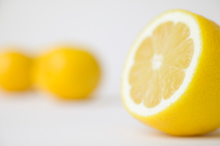
Citric acid in lemon juice immobilises sperm. Photo / Thinkstock
More than 200 years after Casanova employed their contraceptive
qualities, lemons are making a comeback as a way to stop sperm in their tracks.
Scientists from Sydney's Genea fertility clinic are planning to replace
the carcinogenic chemical formaldehyde with lemon juice to analyse sperm
samples in their laboratories. The citric acid in lemon juice immobilises
sperm, allowing scientists to conduct accurate sperm counts and analyse the
samples for abnormalities, said Genea's scientific director Steve McArthur.
The clinic has successfully trialed the new method on 50 samples and
will validate the results in a further study before completely switching to
lemon juice, probably within months, Mr McArthur said. The initial trial showed
lemon juice was just as effective as formaldehyde in immobilising sperm, he
said. Scientists wanted to move from using the dangerous chemical, which is
often used to preserve bodies in medical laboratories, to a natural
alternative. "The lemon juice makes a much more safe and efficient way for
us to be able to process our sperm in our laboratory,'' Mr McArthur said. "The
benefit, not just for our laboratory but all laboratories in Australia and
globally, is that we take a potentially harmful chemical out of our labs. "In
those labs we have sperm samples that are going to be used in the production of
embryos, so any time that we can make that system safer is of benefit to our
patients.''
However, Mr McArthur said the sperm used to fertilise embryos never
comes into contact with formaldehyde, which is simply used to analyse men's
sperm for deficiencies before assisted reproductive therapy begins. Male
infertility is the underlying cause for about 40 per cent of couples who have
trouble conceiving.
The 18th century lover Casanova was said to have discovered the
contraceptive qualities of lemons, using half a squeezed lemon as a uterine
cap. Lemon juice was also thought to be used as a contraceptive by
Mediterranean women about 300 years ago. The results of Genea's study are to be
presented at the Fertility Society of Australia annual scientific meeting in
Auckland next week.
The latest figures on assisted reproductive technology (ART) in
Australia and New Zealand, released on Friday, showed there were about 56,500
treatment cycles performed in Australia and 5,300 in New Zealand in 2010. This
was a fall of about 13 per cent for Australia and one per cent for New Zealand,
according to the Australian Institute of Health and Welfare. The drop in
Australia in 2010 coincided with a cap on the amount of money that could be
claimed back from Medicare for fertility treatment. About 12,100 babies were
born from the ART treatments in 2010 and almost three quarters were full-term
single births of normal birthweight.
NZ Herald
Please share
Please share
No comments:
Post a Comment